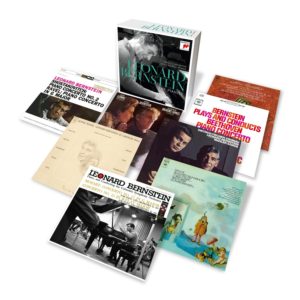 In today’s Wall Street Journal “Sightings” column, I write about a newly released box set that sheds light on an insufficiently appreciated aspect of the phenomenal talent of Leonard Bernstein. Here’s an excerpt.
In today’s Wall Street Journal “Sightings” column, I write about a newly released box set that sheds light on an insufficiently appreciated aspect of the phenomenal talent of Leonard Bernstein. Here’s an excerpt.
* * *
Everybody knows that Leonard Bernstein, who was born a century ago this August, was a man of spectacularly varied gifts. Not only was he a great conductor, but he composed hit shows for Broadway and memorable scores for the concert hall, and he also had a knack for talking about music that he used to unforgettable advantage in his Young People’s Concerts with the New York Philharmonic. Because of all this, it’s easy to forget that Bernstein also played piano on the side—well enough to have had a full-time solo career had he wished it.
If you think I’m stretching the truth, let me point you in the direction of “Leonard Bernstein: The Pianist,” a budget-priced 11-CD box set just out from Sony Classical, which contains all of the commercial recordings that Bernstein made as a pianist between 1947 and 1974 for Columbia and RCA Victor. In addition to playing on his own, he can also be heard performing with the New York Philharmonic, the Israel Philharmonic, London’s Philharmonia Orchesra and the Juilliard String Quartet and accompanying Dietrich Fischer-Dieskau, Christa Ludwig and Jennie Tourel, three of the most celebrated classical singers of the postwar era. The contents include piano concertos by Beethoven, Mozart, Ravel and Shostakovich, each one led from the keyboard by Bernstein; chamber music and songs by Brahms, Mahler, Mozart, Mussorgsky, Poulenc and Schumann; an assortment of Bernstein’s own songs and solo pieces; and two American masterworks, Aaron Copland’s Piano Sonata and George Gershwin’s Rhapsody in Blue, the latter a signature piece with which he was closely identified….
 Most orchestral conductors, of course, can play at least a little piano, and some, like André Previn and George Szell, have been far more than good enough to perform in concert and make noteworthy recordings. But Bernstein, while he seems never to have wanted to be a concert pianist, studied the instrument as seriously as any budding virtuoso….
Most orchestral conductors, of course, can play at least a little piano, and some, like André Previn and George Szell, have been far more than good enough to perform in concert and make noteworthy recordings. But Bernstein, while he seems never to have wanted to be a concert pianist, studied the instrument as seriously as any budding virtuoso….
Not all of Bernstein’s recorded interpretations are equally convincing—his 1959 version of Rhapsody in Blue, for example, is exaggerated to the point of garishness—but his playing is unfailingly crisp and characterful, if occasionally brash. The brashness is, however, the defect of a virtue, for he was incapable of giving a routine performance…
* * *
Read the whole thing here.
Leonard Bernstein plays the first movement of Aaron Copland’s Piano Sonata in 1947:
